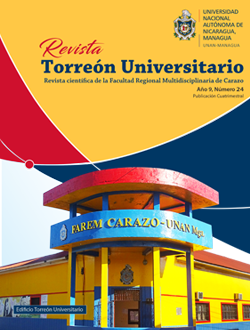Evaluation of DNA extraction methodologies from recalcitrant plants
DOI:
https://doi.org/10.5377/torreon.v9i24.9723Keywords:
DNA, extraction, commercial kits, protocols, recalcitrantAbstract
Obtention of high-quality purified deoxyribonucleic acid (DNA) is key for the subsequent application of molecular techniques during the characterization of species under study. In this regard, plant extracts can be challenging due to its complex metabolites composition and to the fact that often these chemicals concentration differs across varieties and even samples. This is, for instance, the case for recalcitrant samples of cocoa varieties (Theobroma cacao) and coffee (Coffea arabica), where DNA loss can occur during sample maceration due to phenolization. In this research, three commercial kits, already known by producing excellent recoveries for non-recalcitrant varieties, were evaluated. Additionally, the modification of traditional protocols [Doyle & Doyle (1987) and Doyle & Doyle (1990)] was also evaluated. Results obtained confirm the effect of variety and species on DNA extraction and for some species modified methods may yield DNA recovery and purity higher than those obtained by commercial kits.
Downloads
Downloads
Published
How to Cite
Issue
Section
License
Los autores que publican en esta revista están de acuerdo con los siguientes términos.
- El autor o los autores de los artículos, ensayos o investigaciones conceden a la Universidad Nacional Autónoma de Nicaragua, Managua (UNAN-Managua) los derechos de edición (copyright) del trabajo enviado, por consiguiente la Universidad cuenta con el derecho exclusivo para publicar el artículo durante el periodo completo de los derechos de autor.
- Estos derechos de autor/ autores autorizan a la Revista Torreón Universitario y a la Universidad editar y divulgar/publicar el artículo en dicha Revista, incluyendo reproducción impresa y electrónica, el almacenamiento, recuperación y cualquier otro tipo de publicación, y fuentes de información secundaria como servicios de resúmenes y bases de datos, así mismo la facultan a proteger el artículo contra el uso no autorizado para su difusión por medios impresos o electrónicos (PDF, HTML, EPUB, XML u otros).
Licencia para el uso del contenido
La revista hace uso de la Licencia Creative Commons Atribución-NoComercial-SinDerivar 4.0 Internacional.
Bajo esta declaración:

Este revista está sujeta a una licencia de Creative Commons Reconocimiento-NoComercial-SinObraDerivada 4.0 Internacional. Puede ser copiada, distribuida y transmitida públicamente siempre y cuando se cite al autor y la fuente (Revista Torreón Universitario), no debe modificarse ni utilizarse con ningún fin comercial. La licencia completa se puede consultar en http://creativecommons.org/licenses/by-nc-nd/4.0/.

